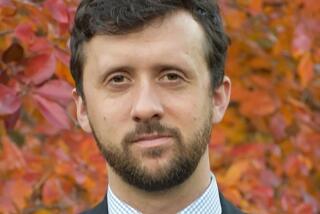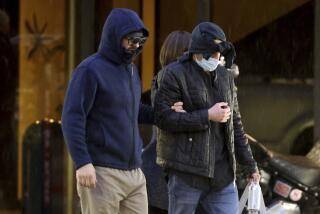Running of Ship Called Sloppy : Part of Arms Money Tied to Misadventures of Erria
- Share via
COPENHAGEN — The latest autopsy of the Iran- contra scandal, issued Thursday by the Tower Commission, revives two basic questions that had been all but forgotten in the dash to nab the villains of the affair: What did former White House aide Lt. Col. Oliver L. North do with the millions he hid in Swiss banks? And how did he do it?
The full answers may not be known for years. But a swatch of the scandal now unraveling in Denmark suggests that a good deal of the money--perhaps $3 million or more--was plowed into the misadventures of a peeling, blue-and-white 163-foot coastal steamer called the Erria.
How that was done is undisputed among observers: very sloppily.
“The whole operation was done by amateurs,” one European figure in the scandal scoffed last week. “This was no exception.”
The Erria, a Danish-flag freighter that North and two key associates bought last April and put to sea for eight months of derring-do, makes that point. It offers an intriguing and sometimes comical glimpse of how North and his associates tried to cloak the Iran-contra operation in secrecy.
With help from the Tower report, the history of the Erria reveals how North and two associates--retired Air Force Maj. Gen. Richard V. Secord and Iranian-born California businessman Albert A. Hakim--ran the ship and other parts of the Iran-contra operation like a multinational holding company, right down to the flow charts and balance sheets.
And it hints at how North, William J. Casey, former director of the CIA, and other Administration officials could have allowed private friendships and business relationships to become entwined with their efforts on behalf of the contras.
The unlikely missions of the small ship--gunrunning, attempted ransoms, espionage--have been detailed in recent weeks. Less known, however, is the network that stood behind them: at least three Panamanian shell companies, a CIA front, a former CIA official, Swiss accountants and a lawyer, an unknown number of bank accounts and an otherwise legitimate Danish company that served as a front for the whole adventure.
Links to Swiss Accounts
Much, if not all, of the $3-million price tag may have been paid from accounts now frozen by the Swiss government at the request of the U.S. Justice Department, which is probing the Iran scandal. The full story cannot be assembled until the Swiss open the accounts to U.S. investigators, which can only occur after a proceeding in which Swiss officials hear the objections of account holders to any release of information.
It is known that one account, that of the Panamanian dummy firm Lake Resources Inc., was a major repository for cash from the Iran arms deal, a $10-million donation to the contras from the Sultan of Brunei, and other North sidelines.
The Erria’s purchase price was 2 1/2 million kroner, or $312,500, at the time that Danish sea captain Arne Herup sold it on April 28 of last year, according to Herup’s agents.
Between that time and the Erria’s last port of call in January is a half-covered trail of bank transfers, legal grants and actions that hint at how North & Co. manipulated their shell businesses and operatives without exposing their own role in the operations.
Worked Hand-in-Hand
At the start are two firms that figure in virtually every aspect of the Iran-contra affair: Compagnie de Services Fiduciaires, of Geneva, and Quijano & Associates, a law firm in Panama City. Although neither had any active role in North’s missions, they worked hand-in-hand to provide the covers that made possible the secrecy that was deemed so essential to his work.
CSF is a fiduciary firm. It provided mailboxes and Swiss bank accounts to a number of firms tied to the Iran dealings and the contra aid pipeline. Its ties go back at least a decade to Stanford Technology Corp., a Hakim-owned firm that later took on Secord as a director and its chief deal maker.
Quijano, often with CSF’s help, provided officers and addresses for shell companies in Panama. One of these was Lake Resources, a Panama firm with Swiss addresses and officers. Another was Dolmy Business Inc., a Panama company set up for North, Secord and Hakim but staffed exclusively with officers from Quijano and CSF.
Newly released documents from the Tower panel suggest that both firms were set up by North as anonymous “collectors” of money for funneling to other companies or people. Lake Resources played the role admirably, serving as the conduit for arms sales to Iran and for the apparent later diversion of money to other projects.
Whether Dolmy ever did the same is not known, but CSF did use the company last April to buy a ship for North. In one indication of how North’s network could work in darkness, sources say CSF manager Willard I. Zucker, an ex-Internal Revenue Service lawyer now living in Switzerland, traveled to Denmark with Hakim for the Erria’s purchase last April.
Given Power of Attorney
To preserve secrecy, Zucker gave Hakim an anonymous power of attorney to act for Dolmy in buying and operating the ship, according to a document seen by The Times. For three days, the two men bargained with Arne Herup, the Erria’s owner.
“The Danish captain is up and eager for the mission--he works for us,” the Tower report quotes Secord as telling North. “We are asking . . . for firm fixed-price contract of $1.2 M (million) for six months . . . . Our rough guess is that monthly operation costs will be $50 K (thousand).”
The Erria was bought in Dolmy’s name with money transferred from a Swiss bank account, sources say, and chartered immediately to a third Panamanian company, Udall Research Corp., also set up by Quijano. The Tower report notes that Secord had acknowledged a transfer of $650,000, apparently from Lake Resources to Udall, two weeks earlier.
On a flow chart of companies prepared by North, Udall is designated as an “operations” firm--a doer, instead of a passive cash-collector like Dolmy. And Udall was a busy company. Upon its founding in April, 1985, it financed the building of a secret 6,250-foot airstrip in Costa Rica, a few miles from the Nicaragua border.
In early 1986, it wrote a $475,000 check to purchase a C-123 transport plane that was operated in the name of Southern Air Transport, a Miami firm that ran military supply airdrops to the contras at Secord’s direction. The same C-123 was shot down over Nicaragua last October, triggering the collapse of Secord’s supply pipeline.
Origin of Money Uncertain
Where Udall got money for the Erria is uncertain. North’s flow chart links the firm directly to Lake Resources. For the next eight months, in any case, Hakim and Secord directed the Erria around the Mediterranean and Baltic seas and the Indian Ocean as if it were sailing on a lake of dollar bills.
Instead of the $50,000 a month that was projected for operating expenses, sources say, the Erria cost Udall and its silent partners upward of $100,000 a month. The vessel was once sent to an obscure Italian port to sit at anchor for more than a week, paying harbor fees and other expenses that could have been avoided were the ship a few miles offshore. At one point it anchored off Oman for 32 days; at another it sailed around Portugal for 1 1/2 months.
‘Tough Guy’
“Hakim was a tough guy in the negotiations,” one source said, “but they were amateurs” in the shipping business. “They didn’t run it right and lost all kinds of money. They obviously weren’t working for money.”
They were not, at least, when funds welled endlessly from North’s Swiss accounts. When the Erria began running guns later that summer, however, matters grew more serious. A shipment of 358 tons of Portuguese and Polish munitions, arranged in June, was funneled not through a dummy firm but through a private concern run by Secord and Hakim: Energy Resources International.
Energy Resources is another Quijano firm--but a moneymaker, not a shell. Its Panamanian officers were ousted in 1978 and replaced with CSF and other Swiss officials, some of whom also served on the board of Stanford Technology.
Sells Arms to Central America
Its only known business is weapons sales to Central America, a line of work it has engaged in since at least 1984. The company was the receiver of $2.2 million in arms that were loaded aboard the Erria--for delivery to the contras, sources say--last summer.
It is not known whether that $2.2 million was ponied up by Hakim and Secord themselves or by one of North’s Swiss accounts. Last autumn, after the plan to send the weapons to the contras fell through, the arms were sold to the CIA for a reported $1.2 million.
The CIA used its own front company, Overseas Trading, to cover the purchase, and its own Swiss arms-purchasing account to pay for it. What happened to the CIA’s $1.2 million is not known, either.
But there were new hints last week that the purchase was some kind of favor--a bailout, or a gift--arranged for Secord and Hakim by their Administration associates. Messages between North and former National Security Adviser John M. Poindexter, cited by the Tower panel Thursday, noted that the two men were seeking at the precise time of the CIA purchase to “make things right for Dick (Secord)” by giving him a contract to ferry captured Soviet arms from Israel to Central America aboard the Erria.
That shipment was to be “a private deal between Dick and (Israeli Defense Minister Yitzhak) Rabin that we bless,” Poindexter wrote.
Secord’s lawyer did not return repeated telephone calls seeking his comment on the Tower panel’s report.
Reportedly Lost $1 Million
One source said that Hakim lost $1 million on the deal but added: “Iranians always say they’re losing money.”
It sounds like the stuff of spy novels. But sources say North, Hakim and Secord ran the Erria more like Maxwell Smart than James Bond.
Vast sums of money were wasted at anchor in various European harbors. To justify bizarre ship movements, such as one mid-Atlantic U-turn, the crew was told to create mechanical troubles that required repairs but also embarrassed the Danish ship operators.
Last May, North was chastised by his boss, Poindexter, for bragging to the CIA that he owned a ship that they could use for secret missions.
Despite repeated warnings from their Danish friends, the three persisted in sending sensitive instructions to the Erria over radio frequencies monitored by the entire Danish maritime fleet.
And it appears that the relationship among the three engineers of the Iran-contra affair was not always harmonious. In running the Erria, sources say, Secord was ever the military man, spending money with abandon to reach his goals. Hakim, supposedly the financial brains of the Iran and contra deals, groused constantly about turning a buck.
The Talk Was Money
In negotiations last April to buy the Erria, Hakim confused the Danish seaman who owned the ship by telling him the deal would benefit them both: “You make money--I make money,” he said.
Behind his back, Secord derisively called Hakim “the genius” and once ordered a container of munitions opened up on the ship to verify that it actually held what Hakim said it did.
A fiscal genius Hakim was not, and this was proved last month--when the Erria was seized in Korsor, Denmark, for $200,000 in unpaid bills that Hakim is said to owe.
Michael Wines reported from Washington and William C. Rempel from Copenhagen.
More to Read
Sign up for Essential California
The most important California stories and recommendations in your inbox every morning.
You may occasionally receive promotional content from the Los Angeles Times.










